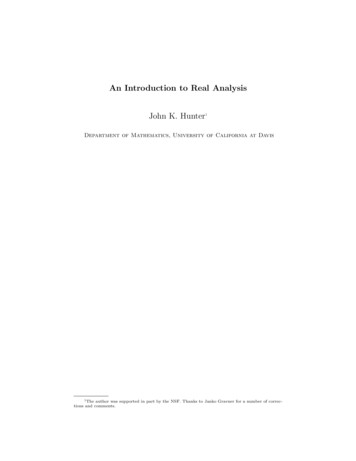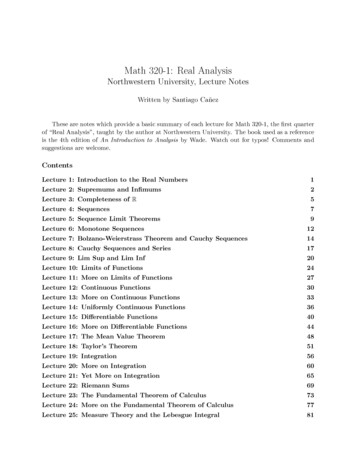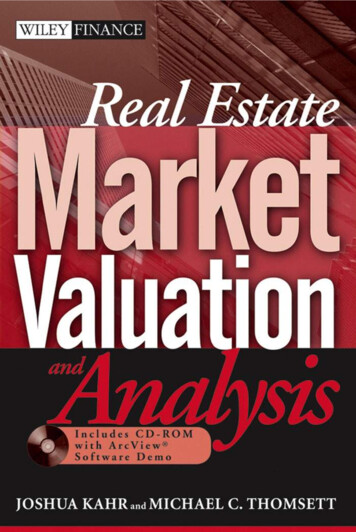
Transcription
An Introduction to Real AnalysisJohn K. Hunter1Department of Mathematics, University of California at Davis1The author was supported in part by the NSF. Thanks to Janko Gravner for a number of corrections and comments.
Abstract. These are some notes on introductory real analysis. They coverthe properties of the real numbers, sequences and series of real numbers, limitsof functions, continuity, differentiability, sequences and series of functions, andRiemann integration. They don’t include multi-variable calculus or containany problem sets. Optional sections are starred.c John K. Hunter, 2014
ContentsChapter 1.Sets and Functions11.1.Sets11.2.Functions51.3.Composition and inverses of functions71.4.Indexed sets81.5.Relations111.6.Countable and uncountable sets14Chapter 2.Numbers212.1.Integers222.2.Rational numbers232.3.Real numbers: algebraic properties252.4.Real numbers: ordering properties262.5.The supremum and infimum272.6.Real numbers: completeness292.7.Properties of the supremum and infimum31Chapter 3.Sequences353.1.The absolute value353.2.Sequences363.3.Convergence and limits393.4.Properties of limits433.5.Monotone sequences453.6.The lim sup and lim inf483.7.Cauchy sequences543.8.Subsequences55iii
ivContents3.9.The Bolzano-Weierstrass theoremChapter 4. Series4.1. Convergence of series4.2. The Cauchy condition4.3. Absolutely convergent series4.4. The comparison test4.5. * The Riemann ζ-function4.6. The ratio and root tests4.7. Alternating series4.8. Rearrangements4.9. The Cauchy product4.10. * Double series4.11. * The irrationality of e57595962646668697173777886Chapter 5. Topology of the Real Numbers5.1. Open sets5.2. Closed sets5.3. Compact sets5.4. Connected sets5.5. * The Cantor set89899295102104Chapter 6. Limits of Functions6.1. Limits6.2. Left, right, and infinite limits6.3. Properties of limits109109114117Chapter 7. Continuous Functions7.1. Continuity7.2. Properties of continuous functions7.3. Uniform continuity7.4. Continuous functions and open sets7.5. Continuous functions on compact sets7.6. The intermediate value theorem7.7. Monotonic functions121121125127129131133136Chapter 8. Differentiable Functions8.1. The derivative8.2. Properties of the derivative8.3. The chain rule8.4. Extreme values8.5. The mean value theorem139139145147150152
Contents8.6.8.7.8.8.Taylor’s theorem* The inverse function theorem* L’Hôspital’s rulev154157162Chapter 9. Sequences and Series of Functions9.1. Pointwise convergence9.2. Uniform convergence9.3. Cauchy condition for uniform convergence9.4. Properties of uniform convergence9.5. .10.5.10.6.10.7.10. Power SeriesIntroductionRadius of convergenceExamples of power seriesAlgebraic operations on power seriesDifferentiation of power seriesThe exponential function* Smooth versus analytic 11.3.11.4.11.5.11.6.11.7.11.8.11. The Riemann IntegralThe supremum and infimum of functionsDefinition of the integralThe Cauchy criterion for integrabilityContinuous and monotonic functionsLinearity, monotonicity, and additivityFurther existence results* Riemann sums* The Lebesgue .2.12.3.12.4.12.5.12.6.12.7.12. Properties and Applications of the IntegralThe fundamental theorem of calculusConsequences of the fundamental theoremIntegrals and sequences of functionsImproper Riemann integrals* Principal value integralsThe integral test for seriesTaylor’s theorem with integral remainder241241246251255261265268Chapter 13. Metric, Normed, and Topological Spaces13.1. Metric spaces13.2. Normed spaces271271276
viContents13.3.Open and closed sets27913.4.Completeness, compactness, and continuity28213.5.Topological spaces28713.6.13.7.* Function spaces* The Minkowski inequality289293Bibliography299
Chapter 1Sets and FunctionsWe understand a “set” to be any collection M of certain distinct objectsof our thought or intuition (called the “elements” of M ) into a whole.(Georg Cantor, 1895)In mathematics you don’t understand things. You just get used to them.(Attributed to John von Neumann)In this chapter, we define sets, functions, and relations and discuss some oftheir general properties. This material can be referred back to as needed in thesubsequent chapters.1.1. SetsA set is a collection of objects, called the elements or members of the set. Theobjects could be anything (planets, squirrels, characters in Shakespeare’s plays, orother sets) but for us they will be mathematical objects such as numbers, or setsof numbers. We write x X if x is an element of the set X and x / X if x is notan element of X.If the definition of a “set” as a “collection” seems circular, that’s because itis. Conceiving of many objects as a single whole is a basic intuition that cannotbe analyzed further, and the the notions of “set” and “membership” are primitiveones. These notions can be made mathematically precise by introducing a systemof axioms for sets and membership that agrees with our intuition and proving otherset-theoretic properties from the axioms.The most commonly used axioms for sets are the ZFC axioms, named somewhatinconsistently after two of their founders (Zermelo and Fraenkel) and one of theiraxioms (the Axiom of Choice). We won’t state these axioms here; instead, we use“naive” set theory, based on the intuitive properties of sets. Nevertheless, all theset-theory arguments we use can be rigorously formalized within the ZFC system.1
21. Sets and FunctionsSets are determined entirely by their elements. Thus, the sets X, Y are equal,written X Y , ifx X if and only if x Y.It is convenient to define the empty set, denoted by , as the set with no elements.(Since sets are determined by their elements, there is only one set with no elements!)If X 6 , meaning that X has at least one element, then we say that X is nonempty.We can define a finite set by listing its elements (between curly brackets). Forexample,X {2, 3, 5, 7, 11}is a set with five elements. The order in which the elements are listed or repetitionsof the same element are irrelevant. Alternatively, we can define X as the set whoseelements are the first five prime numbers. It doesn’t matter how we specify theelements of X, only that they are the same.Infinite sets can’t be defined by explicitly listing all of their elements. Nevertheless, we will adopt a realist (or “platonist”) approach towards arbitrary infinitesets and regard them as well-defined totalities. In constructive mathematics andcomputer science, one may be interested only in sets that can be defined by a rule oralgorithm — for example, the set of all prime numbers — rather than by infinitelymany arbitrary specifications, and there are some mathematicians who considerinfinite sets to be meaningless without some way of constructing them. Similarissues arise with the notion of arbitrary subsets, functions, and relations.1.1.1. Numbers. The infinite sets we use are derived from the natural and realnumbers, about which we have a direct intuitive understanding.Our understanding of the natural numbers 1, 2, 3, . . . derives from counting.We denote the set of natural numbers byN {1, 2, 3, . . . } .We define N so that it starts at 1. In set theory and logic, the natural numbersare defined to start at zero, but we denote this set by N0 {0, 1, 2, . . . }. Historically, the number 0 was later addition to the number system, primarily by Indianmathematicians in the 5th century AD. The ancient Greek mathematicians, suchas Euclid, defined a number as a multiplicity and didn’t consider 1 to be a numbereither.Our understanding of the real numbers derives from durations of time andlengths in space. We think of the real line, or continuum, as being composed of an(uncountably) infinite number of points, each of which corresponds to a real number,and denote the set of real numbers by R. There are philosophical questions, goingback at least to Zeno’s paradoxes, about whether the continuum can be representedas a set of points, and a number of mathematicians have disputed this assumptionor introduced alternative models of the continuum. There are, however, no knowninconsistencies in treating R as a set of points, and since Cantor’s work it has beenthe dominant point of view in mathematics because of its precision, power, andsimplicity.
1.1. Sets3We denote the set of (positive, negative and zero) integers byZ {. . . , 3, 2, 1, 0, 1, 2, 3, . . . },and the set of rational numbers (ratios of integers) byQ {p/q : p, q Z and q 6 0}.The letter “Z” comes from “zahl” (German for “number”) and “Q” comes from“quotient.” These number systems are discussed further in Chapter 2.Although we will not develop any complex analysis here, we occasionally makeuse of complex numbers. We denote the set of complex numbers byC {x iy : x, y R} ,where we add and multiply complex numbers in the natural way, with the additionalidentity that i2 1, meaning that i is a square root of 1. If z x iy C, wecall x z the real part of z and y z the imaginary part of z, and we callp z x2 y 2the absolute value, or modulus, of z. Two complex numbers z x iy, w u ivare equal if and only if x u and y v.1.1.2. Subsets. A set A is a subset of a set X, written A X or X A, ifevery element of A belongs to X; that is, ifx A implies that x X.We also say that A is included in X.1 For example, if P is the set of prime numbers,then P N, and N R. The empty set and the whole set X are subsets of anyset X. Note that X Y if and only if X Y and Y X; we often prove theequality of two sets by showing that each one includes the other.In our notation, A X does not imply that A is a proper subset of X (thatis, a subset of X not equal to X itself), and we may have A X. This notationfor non-strict inclusion is not universal; some authors use A X to denote strictinclusion, in which A 6 X, and A X to denote non-strict inclusion, in whichA X is allowed.Definition 1.1. The power set P(X) of a set X is the set of all subsets of X.Example 1.2. If X {1, 2, 3}, thenP(X) { , {1}, {2}, {3}, {2, 3}, {1, 3}, {1, 2}, {1, 2, 3}} .The power set of a finite set with n elements has 2n elements because, indefining a subset, we have two independent choices for each element (does it belongto the subset or not?). In Example 1.2, X has 3 elements and P(X) has 23 8elements.The power set of an infinite set, such as N, consists of all finite and infinitesubsets and is infinite. We can define finite subsets of N, or subsets with finite1By contrast, we say that an element x X is contained in X, in which cases the singleton set{x} is included in X. This terminological distinction is not universal, but it is almost always clear fromthe context whether one is referring to an element of a set or a subset of a set. In fact, before thedevelopment of the contemporary notation for set theory, Dedekind [3] used the same symbol ( ) todenote both membership of elements and inclusion of subsets.
41. Sets and Functionscomplements, by listing finitely many elements. Some infinite subsets, such asthe set of primes or the set of squares, can be defined by giving a definite rulefor membership. We imagine that a general subset A N is “defined” by goingthrough the elements of N one by one and deciding for each n N whether n Aor n / A.If X is a set and P is a property of elements of X, we denote the subset of Xconsisting of elements with the property P by {x X : P (x)}.Example 1.3. The set n N : n k 2 for some k Nis the set of perfect squares {1, 4, 9, 16, 25, . . . }. The set{x R : 0 x 1}is the open interval (0, 1).1.1.3. Set operations. The intersection A B of two sets A, B is the set ofall elements that belong to both A and B; that isx A B if and only if x A and x B.Two sets A, B are said to be disjoint if A B ; that is, if A and B have noelements in common.The union A B is the set of all elements that belong to A or B; that isx A B if and only if x A or x B.Note that we always use ‘or’ in an inclusive sense, so that x A B if x is anelement of A or B, or both A and B. (Thus, A B A B.)The set-difference of two sets B and A is the set of elements of B that do notbelong to A,B \ A {x B : x / A} .If we consider sets that are subsets of a fixed set X that is understood from thecontext, then we write Ac X \ A to denote the complement of A X in X. Notethat (Ac )c A.Example 1.4. IfA {2, 3, 5, 7, 11} ,B {1, 3, 5, 7, 9, 11}thenA B {3, 5, 7, 11} ,A B {1, 2, 3, 5, 7, 9, 11} .Thus, A B consists of the natural numbers between 1 and 11 that are both primeand odd, while A B consists of the numbers that are either prime or odd (orboth). The set differences of these sets areB \ A {1, 9} ,A \ B {2} .Thus, B \ A is the set of odd numbers between 1 and 11 that are not prime, andA \ B is the set of prime numbers that are not odd.
1.2. Functions5These set operations may be represented by Venn diagrams, which can be usedto visualize their properties. In particular, if A, B X, we have De Morgan’s laws:(A B)c Ac B c ,(A B)c Ac B c .The definitions of union and intersection extend to larger collections of sets ina natural way.Definition 1.5. Let C be a collection of sets. Then the union of C is[C {x : x X for some X C} ,and the intersection of C is\C {x : x X for every X C} .If C {A, B}, then this definition reduces to our previous one for A B andA B.The Cartesian product X Y of sets X, Y is the set of all ordered pairs (x, y)with x X and y Y . If X Y , we often write X X X 2 . Two orderedpairs (x1 , y1 ), (x2 , y2 ) in X Y are equal if and only if x1 x2 and y1 y2 . Thus,(x, y) 6 (y, x) unless x y. This contrasts with sets where {x, y} {y, x}.Example 1.6. If X {1, 2, 3} and Y {4, 5} thenX Y {(1, 4), (1, 5), (2, 4), (2, 5), (3, 4), (3, 5)} .Example 1.7. The Cartesian product of R with itself is the Cartesian plane R2consisting of all points with coordinates (x, y) where x, y R.The Cartesian product of finitely many sets is defined analogously.Definition 1.8. The Cartesian products of n sets X1 , X2 ,. . . ,Xn is the set ofordered n-tuples,X1 X2 · · · Xn {(x1 , x2 , . . . , xn ) : xi Xi for i 1, 2, . . . , n} ,where (x1 , x2 , . . . , xn ) (y1 , y2 , . . . , yn ) if and only if xi yi for every i 1, 2, . . . , n.1.2. FunctionsA function f : X Y between sets X, Y assigns to each x X a unique elementf (x) Y . Functions are also called maps, mappings, or transformations. The setX on which f is defined is called the domain of f and the set Y in which it takesits values is called the codomain. We write f : x 7 f (x) to indicate that f is thefunction that maps x to f (x).Example 1.9. The identity function idX : X X on a set X is the functionidX : x 7 x that maps every element to itself.Example 1.10. Let A X. The characteristic (or indicator) function of A,χA : X {0, 1},
61. Sets and Functionsis defined by(1 if x A,χA (x) 0 if x / A.Specifying the function χA is equivalent to specifying the subset A.Example 1.11. Let A, B be the sets in Example 1.4. We can define a functionf : A B byf (2) 7,f (3) 1,f (5) 11, f (7) 3,f (11) 9,and a function g : B A byg(1) 3,g(3) 7,g(5) 2, g(7) 2, g(9) 5,g(11) 11.Example 1.12. The square function f : N N is defined byf (n) n2 , which we also write as f : n 7 n2 . The equation g(n) n, where n is thepositive square root, defines a function g : N R, but h(n) n does not definea function since it doesn’t specify a unique value for h(n). Sometimes we use aconvenient oxymoron and refer to h as a multi-valued function.One way to specify a function is to explicitly list its values, as in Example 1.11.Another way is to give a definite rule, as in Example 1.12. If X is infinite and f isnot given by a definite rule, then neither of these methods can be used to specifythe function. Nevertheless, we suppose that a general function f : X Y may be“defined” by picking for each x X a corresponding value f (x) Y .If f : X Y and U X, then we denote the restriction of f to U byf U : U Y , where f U (x) f (x) for x U .In defining a function f : X Y , it is crucial to specify the domain X ofelements on which it is defined. There is more ambiguity about the choice ofcodomain, however, since we can extend the codomain to any set Z Y and definea function g : X Z by g(x) f (x). Strictly speaking, even though f and ghave exactly the same values, they are different functions since they have differentcodomains. Usually, however, we will ignore this distinction and regard f and g asbeing the same function.The graph of a function f : X Y is the subset Gf of X Y defined byGf {(x, y) X Y : x X and y f (x)} .For example, if f : R R, then the graph of f is the usual set of points (x, y) withy f (x) in the Cartesian plane R2 . Since a function is defined at every point inits domain, there is some point (x, y) Gf for every x X, and since the value ofa function is uniquely defined, there is exactly one such point. In other words, foreach x X the “vertical line” Lx {(x, y) X Y : y Y } through x intersectsthe graph of a function f : X Y in exactly one point: Lx Gf (x, f (x)).Definition 1.13. The range, or image, of a function f : X Y is the set of valuesran f {y Y : y f (x) for some x X} .A function is onto if its range is all of Y ; that is, iffor every y Y there exists x X such that y f (x).
1.3. Composition and inverses of functions7A function is one-to-one if it maps distinct elements of X to distinct elements ofY ; that is, ifx1 , x2 X and x1 6 x2 implies that f (x1 ) 6 f (x2 ).An onto function is also called a surjection, a one-to-one function an injection, anda one-to-one, onto function a bijection.Example 1.14. The function f : A B defined in Example 1.11 is one-to-one butnot onto, since 5 / ran f , while the function g : B A is onto but not one-to-one,since g(5) g(7).1.3. Composition and inverses of functionsThe successive application of mappings leads to the notion of the composition offunctions.Definition 1.15. The composition of functions f : X Y and g : Y Z is thefunction g f : X Z defined by(g f )(x) g (f (x)) .The order of application of the functions in a composition is crucial and is readfrom from right to left. The composition g f can only be defined if the domain ofg includes the range of f , and the existence of g f does not imply that f g evenmakes sense.Example 1.16. Let X be the set of students in a class and f : X N the functionthat maps a student to her age. Let g : N N be the function that adds up thedigits in a number e.g., g(1729) 19. If x X is 23 years old, then (g f )(x) 5,but (f g)(x) makes no sense, since students in the class are not natural numbers.Even if both g f and f g are defined, they are, in general, different functions.Example 1.17. If f : A B and g : B A are the functions in Example 1.11,then g f : A A is given by(g f )(2) 2,(g f )(3) 3,(g f )(7) 7,(g f )(11) 5.(g f )(5) 11,and f g : B B is given by(f g)(1) 1,(f g)(3) 3,(f g)(7) 7,(f g)(9) 11,(f g)(5) 7,(f g)(11) 9.A one-to-one, onto function f : X Y has an inverse f 1 : Y X defined byf 1 (y) x if and only if f (x) y.Equivalently, f 1 f idX and f f 1 idY . A value f 1 (y) is defined for everyy Y since f is onto, and it is unique since f is one-to-one. If f : X Y is oneto-one but not onto, then one can still define an inverse function f 1 : ran f Xwhose domain in the range of f .The use of the notation f 1 to denote the inverse function should not be confused with its use to denote the reciprocal function; it should be clear from thecontext which meaning is intended.
81. Sets and FunctionsExample 1.18. If f : R R is the function f (x) x3 , which is one-to-one andonto, then the inverse function f 1 : R R is given byf 1 (x) x1/3 .On the other hand, the reciprocal function g 1/f is given by1,g : R \ {0} R.x3The reciprocal function is not defined at x 0 where f (x) 0.g(x) If f : X Y and A X, then we letf (A) {y Y : y f (x) for some x A}denote the set of values of f on points in A. Similarly, if B Y , we letf 1 (B) {x X : f (x) B}denote the set of points in X whose values belong to B. Note that f 1 (B) makessense as a set even if the inverse function f 1 : Y X does not exist.Example 1.19. Define f : R R by f (x) x2 . If A ( 2, 2), then f (A) [0, 4).If B (0, 4), thenf 1 (B) ( 2, 0) (0, 2).If C ( 4, 0), then f 1 (C) .Finally, we introduce operations on a set.Definition 1.20. A binary operation on a set X is a function f : X X X.We think of f as “combining” two elements of X to give another elementof X. One can also consider higher-order operations, such as ternary operationsf : X X X X, but will will only use binary operations.Example 1.21. Addition a : N N N and multiplication m : N N N arebinary operations on N wherea(x, y) x y,m(x, y) xy.1.4. Indexed setsWe say that a set X is indexed by a set I, or X is an indexed set, if there is anonto function f : I X. We then writeX {xi : i I}where xi f (i). For example, {1, 4, 9, 16, . . . } n2 : n N .The set X itself is the range of the indexing function f , and it doesn’t depend onhow we index it. If f isn’t one-to-one, then some elements are repeated, but thisdoesn’t affect the definition of the set X. For example, { 1, 1} {( 1)n : n N} ( 1)n 1 : n N .
1.4. Indexed sets9If C {Xi : i I} is an indexed collection of sets Xi , then we denote the unionand intersection of the sets in C by[\Xi {x : x Xi for some i I} ,Xi {x : x Xi for every i I} ,i Ii Ior similar notation.Example 1.22. For n N, define the intervalsAn [1/n, 1 1/n] {x R : 1/n x 1 1/n},Bn ( 1/n, 1/n) {x R : 1/n x 1/n}).Then[An [An (0, 1),n 1n N\Bn \Bn {0}.n 1n NThe general statement of De Morgan’s laws for a collection of sets is as follows.Proposition 1.23 (De Morgan). If {Xi X : i I} is a collection of subsets ofa set X, then!c!c[\\[cXi Xi ,Xi Xic .i Ii Ii Ii ISProof. We have xT / i I Xi if and only Tif x / Xi for every i I, which holdsif and only if x i I Xic . Similarly,x /Xi if and only if x / Xi for somei ISi I, which holds if and only if x i I Xic . The following theorem summarizes how unions and intersections map underfunctions.Theorem 1.24. Let f : X Y be a function. If {Yj Y : j J} is a collectionof subsets of Y , then [[\\f 1 Yj f 1 (Yj ) ,f 1 Yj f 1 (Yj ) ;j Jj Jj Jj Jand if {Xi X : i I} is a collection of subsets of X, then!









